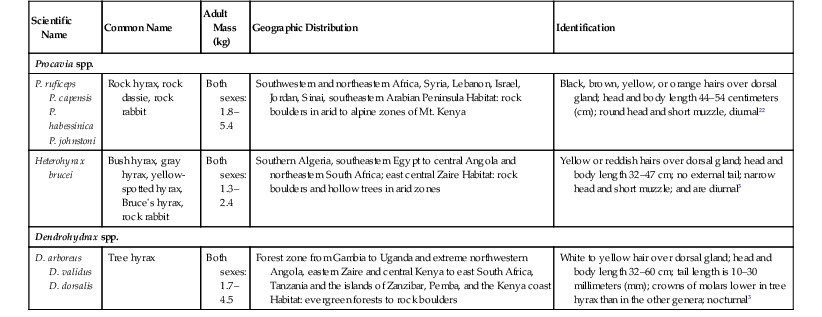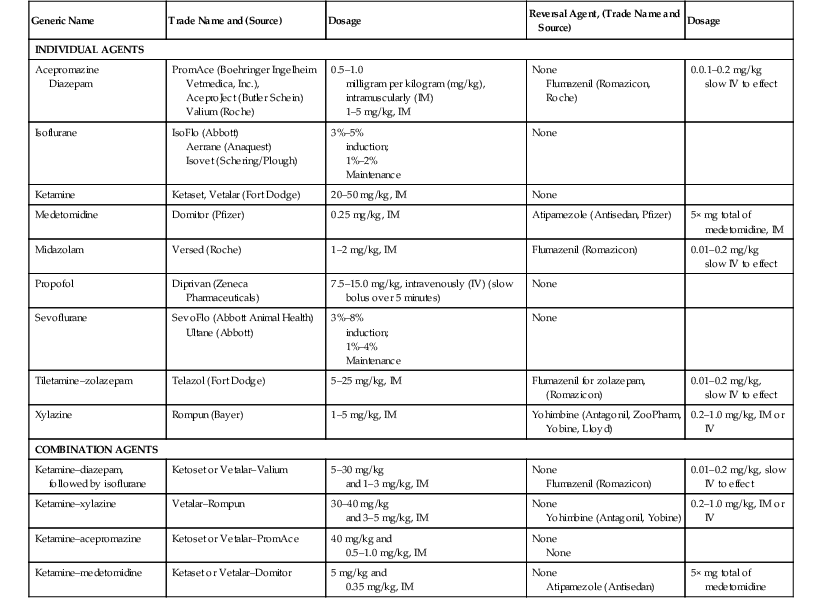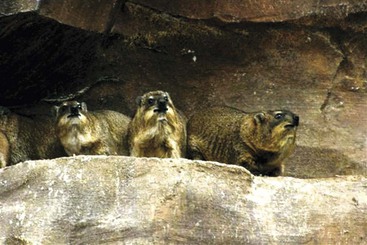Julie E. Napier The hyrax is a unique animal and the only one in the order Hyrocoidea. The one recognized family, Procaviidae, consists of three species: (1) the cape or rock hyrax (Provacia capensis), (2) the gray or yellow-spotted hyrax (Heterohyrax sp.), and (3) the tree or bush hyrax (Dendrohyrax sp.) (Table 54-1). Although the hyrax looks more like a rodent or a rabbit, its closest living relatives are the elephant, as well as the manatee and dugong, both of which are marine mammals. Hyraxes may be found throughout southwest Asia and most of Africa.22 The rock hyrax is the most widely held species in zoologic institutions. TABLE 54-1 Biologic Information on the Hyrax Hyraxes are stout, squat animals with short legs (Figure 54-1). They have a double coat, with a finer under layer and coarser outer layer, and a scent gland on the back covered in longer hairs (see Table 54-1). They have a cleft upper lip, short round ears, and guard hairs around the snout. The deciduous dental formula for the hyrax is: incisors (I) 2/2, canines (C) 1/1, premolars (P) 4/4, for a total of 28 teeth. The permanent dental formula is: I 1/2, C 1/1, P 4/4, molars (M) 3/3 for a total of 38 teeth. Hyrax teeth, which are adapted for eating grasses, have high crowns and relatively short roots. The two upper incisors, used for grooming, are elongated and tusklike in appearance and are often mistaken for canines. These animals are plantigrade, with four digits on the front feet that look like hooves and three digits on the hindfeet. The second digit on the hindfoot has a long claw, also used for grooming. The other two digits are hooflike in appearance as well. The soles of the feet are rubbery in texture, which gives these animals traction on smooth, uneven, or steep surfaces. The only location of sweat glands in this species is the plantar surface of the feet.4 The hyrax’s digestive system is adapted to handle relatively low-quality food. A simple stomach has glandular and nonglandular sections, a tubular small intestine, and a large intestine that is almost as long as the small intestine. The large intestine is unique to this species. It starts with a cecumlike sac, which has a narrow connecting colon with thick walls and a second connecting colon with wide, thin walls. The second portion of the colon is where the primary absorption of water and volatile fatty acids takes place. The two connecting colons are followed by a colonic sac with two appendages that ends with a distal colon. The hindgut is important for microbial digestion.1,10,17 The hyrax does not have a gallbladder. The testicles of the male are intraabdominal and are attached to the posterior pole of the kidney. Females have four mammae and a duplex uterus. The eye of the hyrax is unique, as a portion of the iris above the pupil bulges slightly into the aqueous humor to cut off light directly above the animal.17 The hyrax is a poor thermoregulator, and its body temperature fluctuates in relation to the environment, so it is important to provide a shelter with relatively stable environmental temperatures and humidity. Hyraxes spend many hours basking in the sun and will often huddle in groups when temperatures start to drop. These animals are reluctant to emerge if the weather is cold or rainy, but they may also seek shelter in extreme heat from the sun. They should have a heated area or shelter provided if they are exhibited outdoors. In spite of their build, hyraxes are quick, agile, and adept at climbing. A variety of surfaces should be provided for this activity. They are also capable of jumping up to 1.5 meters (m) so enclosures should be designed accordingly. These animals are quite fastidious and prefer to use a designated area for urinating and defecating, so their exhibit should contain a sandy area for these purposes so that it may be cleaned daily. In the wild, the hyrax is a facultative grazer, feeding on anything from succulents to lower-quality fibrous foods. They spend less than an hour a day eating. The relatively long transit time for digestion, coupled with a low nitrogen requirement, enables this animal to survive periods of poor diet and low protein availability. The hyrax has an effective calcium absorption mechanism in the alimentary canal. The majority of excess calcium is excreted in urine, as in the rabbit, guinea pig, and other rodents. This may give the hyrax urine a chalky appearance. Hemosiderosis has been a concern in the hyrax, so low-iron diets are recommended.3,6 A 2004 study found that hyraxes fed a low-fiber diet were more likely to be affected by pancreatic islet fibrosis (PIF).8 Most zoologic institutions feed hyraxes once a day and offer either some type of pelleted herbivore feed or primate biscuits with a variety of vegetables and greens, a small amount of fruit and some type of hay ad libitum.17 Water is consumed, when available, but is not generally needed. The hyrax efficiently metabolizes water by producing highly concentrated urine, having low evaporative water loss because of the low metabolic rate, and minimal fecal water loss. Consequently, water demand may usually be met in the diet. This species is not known to exhibit copraphagy as adults, but juveniles will eat or may be fed feces to stimulate the appropriate bacteria for a diet high in fiber.17 Some animals, especially those that have been hand raised, will adjust to handling by humans. However, most hyraxes are caught by using a strong hoop net and heavy leather gloves. Care must be taken to avoid causing injury and stress to the animals. Hyraxes may also be run into a crate or trained to go into one. Inhalant anesthesia, specifically isoflurane, is the most common form of anesthesia used in this species. After manual restraint by running the animal from a crate into an induction chamber or by placing a plastic bag over the crate itself, the anesthetic is most often administered via a face mask. It may be challenging to intubate the hyrax, but if intubation is elected, a 4- or 5-millimeter (mm) endotracheal tube may be used.12 Injectable anesthetics may also be used (Table 54-2). The most common reasons for anesthesia are surgery or treatment for trauma, caused either by conspecifics or falls, and for dental disease. TABLE 54-2 Chemical Restraint Agents Used for the Hyrax* * Use lower end of dose range for debilitated, geriatric, or obese animals for optimal results. Venous access sites for this species include the jugular and the femoral veins. Boxes 54-1 and 54-2 list the hematologic and serum chemistry reference ranges, respectively, for the rock hyrax. Annual examinations may include, but are not limited to, blood work; a dental examination and tooth trims, as needed; routine fecal checks for parasites; fecal or rectal culture; nail trims, as needed; and radiography. Vaccinations are given to this species for rabies and tetanus. The necropsy database for hyraxes includes four cases of tetanus as probable cause of death.17
Hyrocoidea (Hyraxes)
Biology
Scientific Name
Common Name
Adult Mass (kg)
Geographic Distribution
Identification
Procavia spp.
P. ruficeps
P. capensis
P. habessinica
P. johnstoni
Rock hyrax, rock dassie, rock rabbit
Both sexes: 1.8–5.4
Southwestern and northeastern Africa, Syria, Lebanon, Israel, Jordan, Sinai, southeastern Arabian Peninsula Habitat: rock boulders in arid to alpine zones of Mt. Kenya
Black, brown, yellow, or orange hairs over dorsal gland; head and body length 44–54 centimeters (cm); round head and short muzzle, diurnal22
Heterohyrax brucei
Bush hyrax, gray hyrax, yellow-spotted hyrax, Bruce’s hyrax, rock rabbit
Both sexes: 1.3–2.4
Southern Algeria, southeastern Egypt to central Angola and northeastern South Africa; east central Zaire Habitat: rock boulders and hollow trees in arid zones
Yellow or reddish hairs over dorsal gland; head and body length 32–47 cm; no external tail; narrow head and short muzzle; and are diurnal3
Dendrohydrax spp.
D. arboreus
D. validus
D. dorsalis
Tree hyrax
Both sexes: 1.7–4.5
Forest zone from Gambia to Uganda and extreme northwestern Angola, eastern Zaire and central Kenya to east South Africa, Tanzania and the islands of Zanzibar, Pemba, and the Kenya coast Habitat: evergreen forests to rock boulders
White to yellow hair over dorsal gland; head and body length 32–60 cm; tail length is 10–30 millimeters (mm); crowns of molars lower in tree hyrax than in the other genera; nocturnal3

Unique Anatomy
Special Housing Requirements
Feeding
Handling and Restraint
Anesthesia and Surgery
Generic Name
Trade Name and (Source)
Dosage
Reversal Agent, (Trade Name and Source)
Dosage
INDIVIDUAL AGENTS
Acepromazine
Diazepam
PromAce (Boehringer Ingelheim Vetmedica, Inc.),
AceproJect (Butler Schein)
Valium (Roche)
0.5–1.0
milligram per kilogram (mg/kg), intramuscularly (IM)
1–5 mg/kg, IM
None
Flumazenil (Romazicon, Roche)
0.0.1–0.2 mg/kg
slow IV to effect
Isoflurane
IsoFlo (Abbott)
Aerrane (Anaquest)
Isovet (Schering/Plough)
3%–5%
induction;
1%–2%
Maintenance
None
Ketamine
Ketaset, Vetalar (Fort Dodge)
20–50 mg/kg, IM
None
Medetomidine
Domitor (Pfizer)
0.25 mg/kg, IM
Atipamezole (Antisedan, Pfizer)
5× mg total of medetomidine, IM
Midazolam
Versed (Roche)
1–2 mg/kg, IM
Flumazenil (Romazicon)
0.01–0.2 mg/kg
slow IV to effect
Propofol
Diprivan (Zeneca Pharmaceuticals)
7.5–15.0 mg/kg, intravenously (IV) (slow bolus over 5 minutes)
None
Sevoflurane
SevoFlo (Abbott Animal Health)
Ultane (Abbott)
3%–8%
induction;
1%–4%
Maintenance
None
Tiletamine–zolazepam
Telazol (Fort Dodge)
5–25 mg/kg, IM
Flumazenil for zolazepam, (Romazicon)
0.01–0.2 mg/kg,
slow IV to effect
Xylazine
Rompun (Bayer)
1–5 mg/kg, IM
Yohimbine (Antagonil, ZooPharm, Yobine, Lloyd)
0.2–1.0 mg/kg, IM or IV
COMBINATION AGENTS
Ketamine–diazepam, followed by isoflurane
Ketoset or Vetalar–Valium
5–30 mg/kg
and 1–3 mg/kg, IM
None
Flumazenil (Romazicon)
0.01–0.2 mg/kg, slow IV to effect
Ketamine–xylazine
Vetalar–Rompun
30–40 mg/kg
and 3–5 mg/kg, IM
None
Yohimbine (Antagonil, Yobine)
0.2–1.0 mg/kg, IM or IV
Ketamine–acepromazine
Ketoset or Vetalar–PromAce
40 mg/kg and
0.5–1.0 mg/kg, IM
None
None
Ketamine–medetomidine
Ketaset or Vetalar–Domitor
5 mg/kg and
0.35 mg/kg, IM
None
Atipamezole (Antisedan)
5× mg total of medetomidine

Diagnostics
Hyrocoidea (Hyraxes)
Chapter 54




